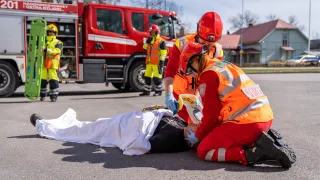FirstFit – Assessing and promoting the functional capacity and work ability of paramedics at all stages of their careers

Objectives
The work of paramedics is physically stressful in many ways. Paramedics are most burdened at work by frequent moving, carrying and lifting tasks. These tasks require muscle strength as well as functional capacity from the respiratory and circulatory systems and good motor control. The more frequently these work phases and stress factors occur during a shift, the greater the total physical load on the work. On average, these work phases are repeated 4–7 times during a shift. The workload of the tasks is increased by the often challenging and varying conditions in the work environment.
There is no uniform practice for assessing and promoting the functional capacity of paramedics based on the requirements of work that supports the maintenance of work ability. This project lays the foundations for providing paramedics with a work-oriented method for assessing, monitoring and providing feedback about their physical functional capacity, including occupational health co-operation.
Data and methods
The project will bring together existing data on physical stress factors, the physical functional capacity and stress experienced by paramedics and the methods and practices for monitoring and promoting the functional capacity. After this, measurements are performed to determine the physical stress and recovery of paramedics at work. Particular attention will be paid to the most physically stressful stages of work. The measurements are used to assess both the stress and recovery of the muscles and circulatory system of the paramedics being tested as well as changes in balance and body control during a shift. The background material is also supplemented with interviews with operators in the field of emergency care and occupational health care services.
The project will be implemented through co-development with operators in the fields of emergency care, sports and occupational health. The project prepares recommendations for tests designed to monitor the physical functional capacity of paramedics as well as the basis for evaluation criteria and test feedback. In addition, a test set with feedback criteria will be piloted for development.
Results and impact
The impetus for the study came from rescue services, where the need to promote the physical functional capacity of paramedics has been identified, especially in lifting tasks, in order to support their coping. If a rescuer works in firefighting, rescue and emergency care services, their physical functional capacity is assessed with a FireFit index derived from the requirements of firefighting and rescue work. There has not been a method for assessing and monitoring physical functional capacity derived from the stress factors of work for paramedics. Some regional rescue departments have introduced their own methods for monitoring physical functional capacity for paramedics, which vary between departments. Paramedics are also employed by hospital districts and private service providers. In the field, there is an identified need for a nationally consistent method derived from the requirements of work.
The method to be developed can be used in the future to anticipate changes in functional capacity. In the future, a uniform method will also make it possible to make different comparisons at a group level, for example by age group, region or nationally. The results can also be used in managing the work ability and career planning of emergency medical personnel.
The lifting, carrying and moving tasks in the social and health care sector, both in primary care and nursing, will increase as the population continues to age
Our experts

Anne Punakallio
Research group
Funding
The Finnish Work Environment Fund, emergency care units, Finnish Institute of Occupational Health



